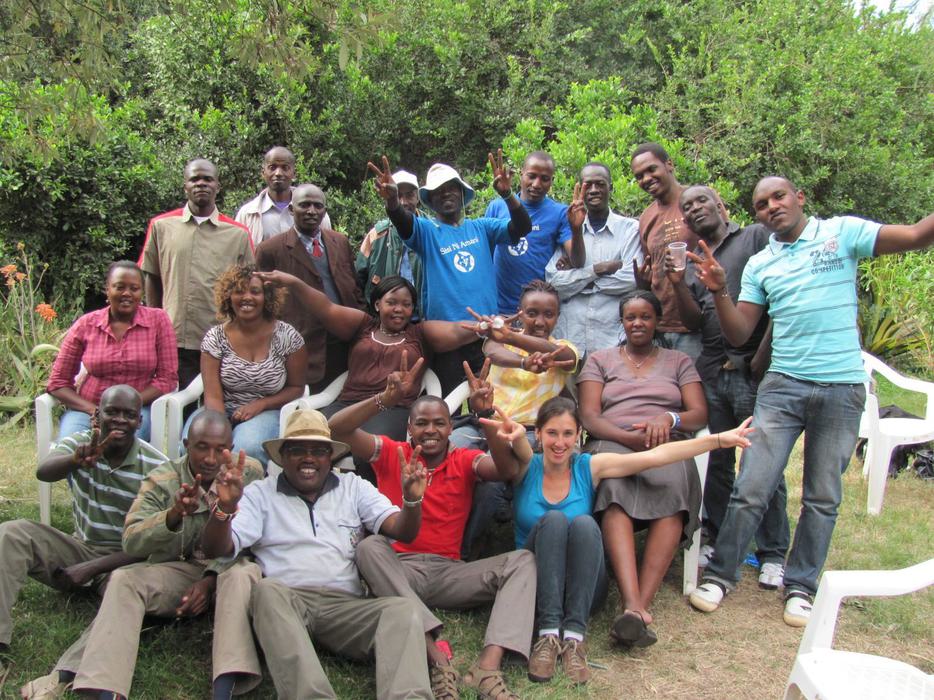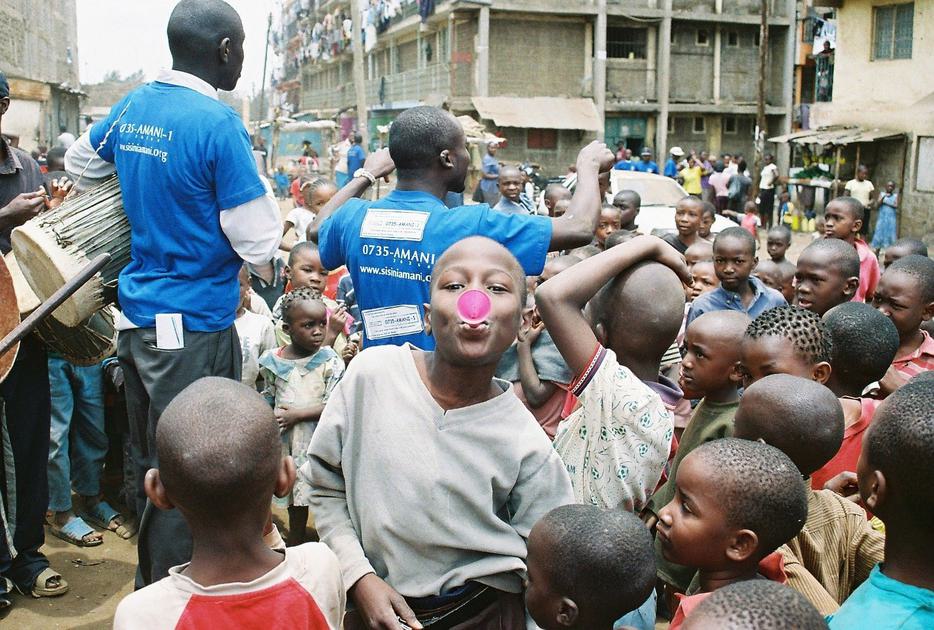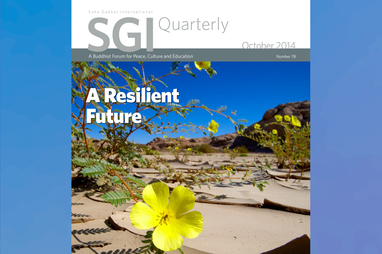SGI Quarterly

[Photo credit: © Primož Kovačič]
Rachel Brown’s research into violence prevention efforts in Kenya during a stay in that country led to her founding Sisi ni Amani Kenya with a group of Kenyan community peace activists. After integrating SNA-K’s model and programs into local NGOs, Rachel is now adapting and applying key lessons from the Kenyan experience in other contexts and is currently a Genocide Prevention Fellow at the US Holocaust Memorial Museum.
Sisi ni Amani Kenya (SNA-K) has pioneered new strategies to build local capacity for peacebuilding and civic engagement.
New technology is changing the way we communicate with each other, increasing the speed and geographical spread over which people can easily share information. This opens up important opportunities for innovative models and approaches to violence prevention. However, these technologies pose their own risks and challenges: they can be and have been used effectively by violent actors to incite and organize violence. Preceding and throughout Kenya’s 2007–8 post-election violence, mobile phones were used effectively by violent actors for the spread of rumors, hate speech, fear-mongering, calls for revenge attacks and the organization of weapons distribution. Traditional peace actors struggled to counter these information flows.
In 2010, I began the process of founding Sisi ni Amani Kenya [We Are Peace Kenya in Swahili]. Recognizing the important role of communication and perceptions in triggering violence, SNA-K pioneered an approach that sought to build a similar capacity for local peace actors in terms of reach, speed and impact of the text messaging medium.
This work embodied the principles of resilience defined by SGI President Daisaku Ikeda in his 2014 peace proposal as “realizing a hopeful future, rooted in people’s natural desire to work together toward common goals” by aiming to improve resistance to the tensions and triggers of violence and supporting the creation of a foundation for cooperation toward a better future.
SNA-K started with the belief that to create sustainable resilience to violent conflict at the local level, it is crucial to build on what already exists: the local networks, groups and individuals committed to preventing conflict and creating positive civic engagement. These groups, networks and individuals have the local knowledge, social capital and incentives to mitigate and respond to violence in their communities, but may lack specific skills or knowledge.

The Sisi ni Amani Kenya team. [Photo credit: © Benjamin Grazda]
SNA-K took a participatory approach: facilitating local peace actors to analyze conflict dynamics and triggers and create a strategy that would allow them to compete with information encouraging violence. Focusing on mobile technology, SNA-K analyzed how information influenced behavior toward violence, and then developed tools and strategies to enable local peace activists to use this technology as or more effectively than violent actors.
Noting that information and rumors about violence spread quickly through forwarded text messages, the SNA-K team developed a program to rapidly reach high numbers of people within communities to counter these information flows. SNA-K built an SMS platform to which community members could subscribe and enter important demographic information such as their location, language preference, age and gender. SNA-K’s team of local peace actors was then able to target messages to thousands of subscribers based on these demographic factors.
Violent propaganda usually has a direct call to action and spreads fast. Peace messages can often be vague and do not spread as quickly. To make high-impact messages and create a brand that community members would listen to, trust and respect, SNA-K engaged top-class marketing expertise from Ogilvy & Mather, applying the same techniques used to sell products to sell peaceful behavior.
Combining local forums and events with door-to-door outreach by members of diverse community-based organizations such as peace groups, youth groups, women’s groups and religious groups, SNA-K reached more than 65,000 subscribers in 20 locations by the March 2013 Kenyan elections. Prior to the elections, SNA-K sent subscribers civic and voter education messages to guide them through the electoral process, including messages letting them know how to identify their correct polling station and which documents to bring with them.
Throughout the election period, SNA-K also monitored the situation on the ground through local networks and a phone-based reporting system and sent messages to quell rumors and mitigate tensions and violence. These messages aimed to intervene in triggers of violence and encourage community members to pause and think about the consequences of their actions. Rather than being prescriptive, the messages asked people to take into consideration factors they might not think about in the heat of the moment. All messages had a specific behavioral change goal—i.e., getting someone not to spread a rumor or to go home instead of staying in a group that was discussing engaging in violence.
While new technology has the potential to influence behavior negatively, it can also be a powerful tool for social resilience.
Tailored Messages
To create high-impact messaging content, SNA-K’s team conducted focus groups with target demographic populations in which participants cocreated messages to intervene and prevent specific behaviors such as spreading rumors. The SNA-K team analyzed these messages, reframed them, vetted them for risk and created situation- and target audience-based message templates, as well as overall message guidelines. During the election cycle, these templates and guidelines formed the basis of the more than 680,000 messages SNA-K sent in the weeks surrounding the elections. Each message was prompted by specific information about on-the-ground events, monitored by SNA-K’s team and local partners.
In a multiple choice survey of 7,350 subscribers following the elections, 75 percent of respondents reported spending their own money to forward an SNA-K message at least once, and 55 percent reported having a conversation about an SNA-K message “often” or “very often.” In the same survey, 92 percent of respondents believed that the messages had a positive impact on preventing violence in their area.
A qualitative phone survey of subscribers offers further evidence of the impact of SNA-K during the elections. One interesting insight from these interviews was that several subscribers noted that the messages made them feel recognized, remembered and secure because someone was paying attention to their area; while others gave second- and firsthand accounts of youth planning to participate in violence being deterred because they received messages and thought it meant that someone was aware of the situation and they might get in trouble.
Responses to the survey included comments such as “People felt like they were being watched when the messages came in and they didn’t want to engage in violence” and “The messages made me relax even in the midst of the violence that was happening . . . it wasn’t a lot of violence but I still felt like someone was in control and watching and I knew things would be OK in the end after reading the message.”

Sisi ni Amani team members reach out to the community in Baba Dogo, an informal settlement in Nairobi [Photo credit: Thatcher Cook/CC BY-SA 2.0/Cropped]
SNA-K partners in various communities reported increased visibility and credibility from being associated with the platform and from working together under a common banner. Some reported receiving free rides on public transport because of their involvement with SNA-K, and many reported being stopped on the street and thanked for their work. This increased visibility and credibility of peace actors, while anecdotal, is important to note, as small numbers of people committed to violence are often more visible than larger numbers of people committed to peace.
SNA-K’s work in Kenya shows potential for the use of new technologies to counter information flows that lead to violence. It demonstrates that while new technology has the potential to influence behavior negatively, it can also be a powerful tool for social resilience. There is a need and an opportunity to learn more about what works and does not work, and to figure out ways to measure the impact of these interventions in order to adapt and improve them. Most importantly, new technology and technology-related peacebuilding interventions must seek to piggyback on existing efforts of local actors. This can be achieved by understanding their current approaches, needs, ideas and contextual analysis, and supporting them to adapt to changes in communications so they can continue to take the lead in making their communities resilient to violent conflict.
Related Content


